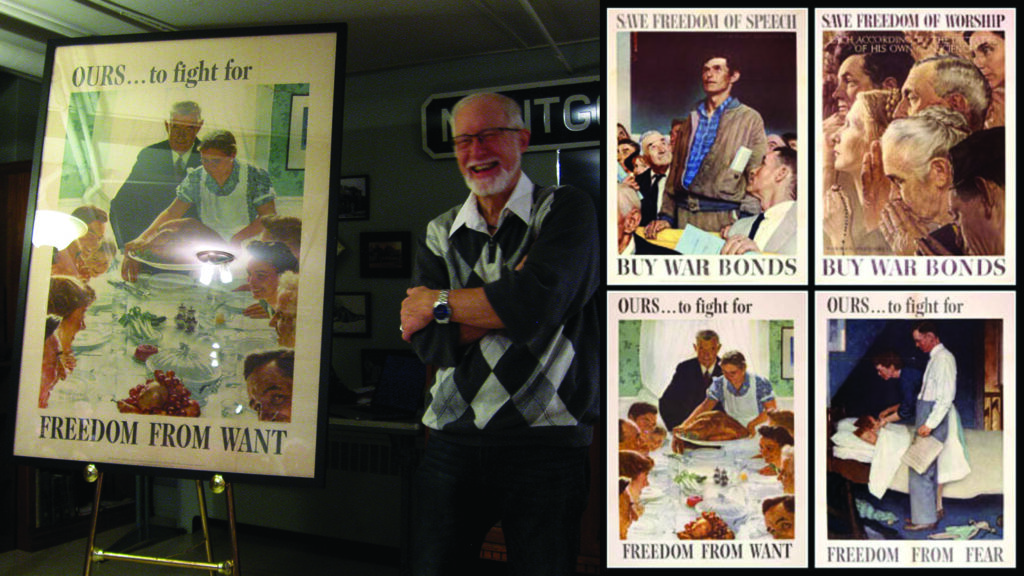
MONTGOMERY – After a recent acquisition that was years in the making, the Montgomery Area Historical Society is now one of only two museums in the country to house the complete collection of Norman Rockwell’s Four Freedoms posters.
The last poster collected is Rockwell’s Freedom From Want poster, which features an elderly woman holding a cooked turkey with a man looking on. The table is set for a large family dinner and each person is smiling and waiting to eat. It is considered one of Rockwell’s finest works.
“Freedom of Want” completes the set of “The Four Freedoms”, which Rockwell painted, According to Larry Stout, vice president of the Montgomery Area Historical Society. The society has each one framed and against the wall (opposite the street entrance) in the Adams Room, downstairs from the Montgomery Library.
Stout explained the history of the poster and how they acquired it to complete the collection, At a society meeting Thursday evening.
Four Freedoms
Between 1929 to 1941 it was a very “dark period for America and just a very sad time” as the Great Depression and World War II were in full motion, Stout said. As the war raged, President Franklin Roosevelt gave his 1941 presidential address. Stout said this was FDR’s way to encourage the citizens of Great Britain. At that time, the U.K. who was the only country standing against Nazi Germany.
“We look forward to a world founded upon four essential human freedoms,” Roosevelt said. “The first is freedom of speech and expression-everywhere in the world. The second is freedom of every person to worship God in his own way-everywhere in the world. The third is freedom from want…The fourth is freedom from fear.”
This became known as the Four Freedoms speech. Stout showed slides of artists who had painted representations of them, but Rockwell wanted to do something more.
Rockwell was born in 1894 and would produce “more than 4,000 original works in his lifetime,” Stout said. “He was commissioned to illustrate more than 40 books, as well as painting the portraits of Presidents Eisenhower, Kennedy, Johnson and Nixon.”
“Rockwell was best known for his Saturday Evening Post Covers,” Stout said. “The first was done in 1916 and would continue until 1963 – a total of 321 cover paintings.”
However, Stout said that Rockwell had hit a creative impasse.
“The artist struggled with how best to visualize the abstract concepts. (Rockwell said)’I juggled the ‘Four Freedoms’ around in my mind, reading a sentence here, a sentence there, trying to find a picture, but it was so high-blown. Somehow I just couldn’t get my mind around it,’ ” Stout said.
Then Rockwell remembered a neighbor of his named Jim Edgerton had spoken at a town meeting. It was not well received.
“(But) They had let him have his say. No one had shouted him down. I thought — that’s it!” Rockwell said. He then began to draw up the ideas and decided to head to Washington, D.C. and visit the Office of War Information (OWI).
Finding a publisher
Stout said the goal was “the illustrations be made into patriotic posters that could be sold to raise funds for the war effort.” But “the man in charge of posters” was not interested and sent Rockwell on his way.
On his way back to Vermont, Rockwell stopped in Philadelphia to visit with Ben Hibbs, the editor of the Saturday Evening Post. The artist and Hibbs talked and he mentioned his failed Washington excursion and showed him his ideas.
Stout said that Hibbs loved the idea and told Rockwell to “drop everything” and “You’ve got to do them for us!” For the next seven months of 1942, Rockwell did just that.
Stout said the project was a “great strain” for Rockwell and he lost 15 pounds working on them. In 1943, the posters appeared in the February and March issues of the Post along with essays about each theme. Stout said they were a success for the Post.
“These ‘freedom’ pictures were a phenomenal success, with The Saturday Evening Post receiving 25,000 reprint requests,” Stout said.
Funding the war effort
In a turn of events, the OWI stepped back in and sent Rockwell on a tour with the posters to raise money for people to buy war bonds.
“The OWI produced and distributed posters of the Four Freedoms to 400,000 retailers, post offices, and libraries via the Boy Scouts. (The OWI) began receiving 2,000 daily poster requests,” Stout said and added that the posters came in collections of three sizes: 20 inches by 28, 28 inches by 40, and 40 inches by 56 inches.
As for their popularity, in 1945, a writer for the New Yorker magazine said the Four Freedoms were “received by the public with more enthusiasm, perhaps, than any other paintings in the history of American art.” Rockwell was able to raise $132 million for the war effort. Stout said that it would be “$2.6 billion in today’s money.”
The journey to Montgomery
Three of the four posters (Freedom of Speech, Freedom of Worship and Freedom from Want) had been in Montgomery since the 1940s, according to Stout. Montgomery resident Marion McCormick elaborated and said those three were original in the library at its previous location (before the bank donated the building in 1986 to the library).
McCormick said the posters moved to the bank building when the library moved. When the Adam Room was established in 2010, the posters were established as “historical” items and given to the historical society.
For the last few years, Stout and other members were on the hunt for Freedom of Want, and in the last year, it was found online. Stout also praised Dewey Oaks, of Jersey Shore, for framing all four of the posters.
For the society to receive all four posters of this size was quite significant, Stout said.
“In our research, the Norman Rockwell Museum (of Stockbridge, Massachusetts) is one of only two museums that has the four original freedom posters in the 40 inches by 56 inches size in the nation. The other being the Adam Museum of the Montgomery Area Historical Society in Montgomery, Pennsylvania,” Stout said.
Society president Mark Shifflet said this find shows the importance of small town museums and historical societies.
“We are just a small historical society and we are not an old one and I think we have a wonderful collection and this is a crowning achievement,” Shifflet said. “You can’t fit all the history of a region in one museum. Having a small historical society allows communities to preserve more of their history with just large regional ones.”
Society member Fae Herb said this gives the museum a “complete feel.”
“How awesome our little town museum has these for display,” Herb said.
The Four Freedoms are currently on display at the Adam Museum of the Montgomery Area Historical Society beneath the Montgomery Public Library on Main Street.




